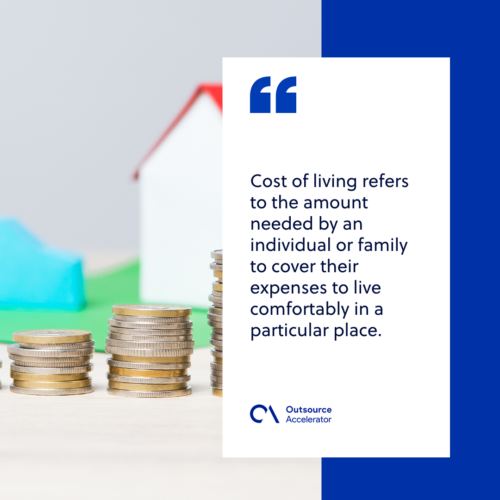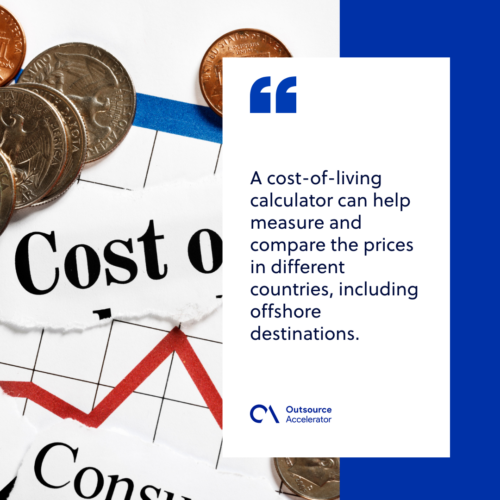The cost of living in top offshoring destinations, ranked

As a business located in a developed country, you might think that low wages in the developing ones are unfair. Skeptics still believe outsourcing exploits cheap labor for their work.
What people don’t realize is that the industry does otherwise. It even helps improve the offshore workers’ lives by offering competitive salaries and benefits. The key to this is the cost of living in offshoring destinations.
If you want to outsource your services and are curious about the wages and expenses in offshore countries, look no further. We have ranked the costs of living in top offshoring destinations in this article.
How is the cost of living calculated?
Cost of living refers to the amount needed by an individual or family to cover their expenses to live comfortably in a particular place.
It is calculated by comparing the prices of necessary expenses in a location and weighted according to spending patterns and individual budgets. These costs are divided into housing, healthcare, food, and utilities.
The cost of living in a location can be compared to another, regardless of geography. With this, experts can determine how expensive a place can be to live comfortably.

The cost of living in top offshoring destinations
A cost-of-living calculator can help measure and compare the prices in different countries, including offshore destinations. Institutions use the cost of living index (CLI) as a way to determine whether a location goes up or down the base cost of living, which is set at 100.
While some of them can be specific to a particular country, most institutions such as Numbeo provide reliable data and comparison for each location.
Using data from Numbeo, we have ranked the cost of living for each offshoring destination, including India and the Philippines.
India
- 2021 population: 1,360,903,399
- Average salary (2020): INR 33,120.47 (US$ 434.05)
- Cost of living index (CLI): 24.43
- Cost of living per month (estimate)
- Single person: INR 25,339.99 (US$ 227.82)
- Family of four: INR 89,172.36 (US$ 1,169.45)
Quick fact:
The cost of living in India is way cheaper compared to the Philippines, though it depends on the city you live in. Mumbai is one of India’s most expensive cities to live in, costing approximately INR 29,507.86 per month for individuals.
Yet, the quality of living in the country has been affected by the pandemic. A 2021 research analysis found that the middle class in the country shrunk by 32 million in 2020 due to the economic downturn brought by COVID-19.
Brazil
- 2021 population: 213,480,000
- Average salary: BRL 8,220.00 (US$ 1,778.30)
- Cost of living index (CLI): 33.24
- Cost of living per month (estimate)
- Single person: BRL 2,395.17 (US$ 518.17)
- Family of four: BRL 8,537.01 (US$ 1,846.88)
Quick fact:
Brazilians are lovers of luxury. Luxury brands have been going to the country’s market since the ‘90s and still exist today. Despite its low cost of living, buying luxury goods in Brazil costs higher than in developed countries such as the UK.
The Philippines
- 2021 population: 110,881,756
- Average salary (2020): PHP 15,200.00 (US$ 308)
- Cost of living index (CLI): 37.06
- Cost of living per month (estimate)
- Single person: PHP 26,578.64 (US$ 507.07)
- Family of four: PHP 91,402.30 (US$ 1,743.79)
Quick fact:
Price aggregator iPrice revealed in its 2021 report that Manila is the third most expensive place to live in Asia. It is not far behind Bangkok on second place with an estimate of PHP 51,500.00 (US$ 982.00) monthly cost of living.
Vietnam
- 2021 population: 89,510,000
- Average salary: VND 6,140,000.00 (US$ 266.60)
- Cost of living index (CLI): 37.48
- Cost of living per month (estimate)
- Single person: VND 10,256,498.74 (US$ 446.55)
- Family of four: VND 36,587,490.28 (US$ 1,592.94)
Quick fact:
Undeniably, Vietnam is one of the safest and least expensive countries to live in Asia. It is even named the cheapest place to live in the world in a 2017 report, jumping from the fifth rank the previous year.
Poland
- 2021 population: 37,881,467
- Average salary (2020): PLN 5,748.24 (US$ 1,337.61)
- Cost of living index (CLI): 38.95
- Cost of living per month (estimate)
- Single person: PLN 2,410.72 (US$ 560.96)
- Family of four: PLN 7,999.58 (US$ 1,861.47)
Quick fact:
Poland is one of the least expensive places to live in Europe. Its capital Warsaw ranked 169th out of 209 cities in the 2020 Mercer Cost of Living ranking.
South Africa
- 2021 population: 60,041,994
- Average salary: SAR 24,051.00 (US$ 1,553.14)
- Cost of living index (CLI): 42.09
- Cost of living per month (estimate)
- Single person: SAR 9,016.64 (US$ 582.27)
- Family of four: SAR 31,313.10 (US$ 2,022.11)
Quick fact:
South Africa has a massive power crisis even today. Eskom, a major power supplier in the country, has recently expanded its “load shedding” measures to five days a week. Businesses and residences would experience power interruptions up to seven hours a day.
Thailand
- 2021 population: 66,770,000
- Average salary: THB 28,454.00 (US$ 838.89)
- Cost of living index (CLI): 43.21
- Cost of living per month (estimate)
- Single person: THB 18,155.68 (US$ 535.27)
- Family of four: THB 65,475.58 (US$ 1,930.38)
Quick fact:
Bangkok and Chiang Mai are some of the most expensive cities to live in Asia as of 2020. As mentioned, Bangkok goes into a neck-on-neck battle with Manila in terms of the cost of living.

The cost of living in offshoring countries vs. developed countries
The figures above prove that offshoring is far from cheap labor. Instead, companies can hire teams at an affordable rate that can match the quality of local hires.
See the comparison between three offshore countries and their markets below for further proof.
| Country | Cost of living index (CLI) | Cost of living (single person) | Cost of living (family of four) |
| India | 24.43 | US$ 227.82 | US$ 1,169.45 |
| Philippines | 37.06 | US$ 507.07 | US$ 1,743.79 |
| Brazil | 33.24 | US$ 518.17 | US$ 1,846.88 |
| United States | 70.13 | US$ 945.52 | US$ 3,351.78 |
| United Kingdom | 69.65 | US$ 846.41 | US$ 2,942.28 |
| Australia | 77.75 | US$ 972.43 | US$ 3,501.02 |
Why should companies outsource to these destinations?
While cost is one of the primary motivators for offshoring services, it should not be your only reason to do so. Offshore countries have several other advantages to offer global companies, including:
- High-quality hires. These countries produce millions of graduates joining the workforce each year. These workers are equipped with the skillsets and attitudes needed to adapt to the workplace.
- Round-the-clock services. Given the time zone differences in offshoring destinations, teams can provide round-the-clock services, making your business more accessible to customers.
- Process improvements. Being experts in the field for decades, BPOs in these destinations can help you improve your processes at hand.







 Independent
Independent




